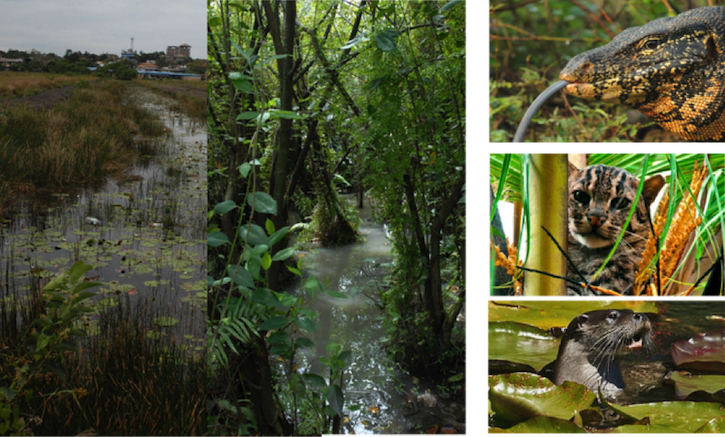
By Terry Townshend
From 21-29 October 2018 delegates from 170 governments and NGOs are gathered in Dubai for the 13th Conference of the Parties (COP13) to the Ramsar Convention on Wetlands.
The Convention, adopted in the Iranian city of Ramsar in 1971, is an intergovernmental treaty that “provides the framework for national action and international cooperation for the conservation and wise use of wetlands and their resources.” Since its inception, 2,326 wetland sites of international importance have been accredited, including 57 in China.
The Convention uses a broad definition of wetlands; it includes all lakes and rivers, underground aquifers, swamps and marshes, wet grasslands, peatlands, oases, estuaries, deltas and tidal flats, mangroves and other coastal areas, coral reefs, and all human-made sites such as fish ponds, rice paddies, reservoirs and salt pans.
The motivation for creating the Ramsar Convention was that the total wetland area and quality were declining in most regions of the world, even though wetlands are indispensable for the benefits—or “ecosystem services”—that they provide humanity, including freshwater supply, food, building materials, biodiversity, flood control, groundwater recharge, and climate change mitigation.
The loss and degradation of wetlands is happening largely due to the lack of awareness about their benefits, which can be difficult to measure. At first glance, wetlands can seem like grim wastelands with little obvious economic value. Particularly in urban areas, they can be viewed as dumping sites or unwanted breeding grounds for disease-carrying mosquitos. In many land-strapped coastal regions, reclaiming coastal wetlands is a cheap way to acquire new land for development. It is therefore not surprising that these areas have often been considered by planners, and the public, as suitable for development. However, when efforts have been made to study and measure the benefits of wetlands, their value is shown to be significant, leading to policy change. Two examples of this are the coastal wetlands of China and urban wetlands in Colombo, Sri Lanka.
Coastal Wetlands in China
Over the past 50 years, 60% of China’s temperate coastal ecosystems, 73% of mangroves, and 80% of coral reefs have been lost, mostly due to economic development. Coastal wetlands in China’s most developed provinces and municipalities—such as Zhejiang, Jiangsu, Tianjin, and Shandong—are hot targets for development projects.
This rapid development has not come without costs. Thanks to studies such as the Paulson Institute’s Blueprint for Coastal Wetlands in China, we now know that many of the decisions to develop these coastal areas have neglected the significant benefits of wetlands—so called “ecosystem services”—including helping to prevent and reduce flooding and storm surges, mitigating climate change by storing carbon, purifying water, and providing sustainable livelihoods for local people, as well as providing invaluable habitat for millions of migratory shorebirds. Such ‘natural capital’ is not reflected on most countries’ balance sheets, but its erosion undermines the ability to achieve sustainable economic growth.
In July 2018, China’s State Council issued a circular stating that land reclamation along its coast would now be under strict control in a bid to maintain “ecological equilibrium,” demonstrating that decision-makers are beginning to recognize the benefits of coastal wetlands.

Urban Wetlands in Colombo, Sri Lanka
On 28 August 2018, the government in Sri Lanka approved recommendations to protect and restore the urban wetlands of the capital, Colombo, following a study by the Wetland Management Division of the Sri Lanka Land Reclamation and Development Corporation, The World Bank and Wildfowl, and Wetlands Trust Consulting.
The study showed that the benefits of Colombo’s urban wetlands included flood damage mitigation, climate regulation (the wetlands maintain lower air temperatures averaging 10 degrees Celsius cooler than hard urban surfaces at the hottest time of the day), freshwater supply, water cycle regulation (including waste water treatment), food security for the urban poor, erosion regulation, pollination, and carbon sequestration. The wetlands also served as a home for more than 250 species of wildlife, including the endangered Fishing Cat, and provided places for recreation and education. In total, these benefits were calculated to be worth 8.8 million RS (USD 54,000, CNY 370,000) per hectare per year (1 to 2 billion RS annually for the whole wetland complex). In addition, if the potential income from recreation was included in the analysis, the annual income for the wetland complex could increase to between 16 to 18 billion RS annually (USD 95-106 million, CNY 650-730 million).

This new analysis provides decision-makers with confidence that the most robust decision for Colombo’s future is to treat the wetland areas as no-development zones.
Fittingly, in recognition of its comprehensive approach to wetland management adopted across the city, Colombo has received formal accreditation as a Wetland City from the Ramsar Convention.
Capturing and disseminating good practices is the most effective way to accelerate an increase in awareness of the value of wetlands worldwide. That is why the Paulson Institute is delighted to contribute to a new handbook on good practice in urban wetland conservation. The handbook, a partnership between the Ramsar Secretariat, China’s National Forestry and Grassland Administration, Nanjing University and the UK’s Wildfowl and Wetlands Trust, is entitled “Good Practice Handbook for Integrating Urban Development and Wetland Conservation” and was launched at a special event in Dubai on 23 October. The handbook was commissioned by the Ramsar Secretariat and will be available to download for free from their website.
Understanding and measuring the value of wetlands, whether they are coastal, freshwater, or urban, will enable governments to make smarter decisions about economic development and urban planning. Given the projections for sea level rise, more extreme precipitation and prolonged higher temperatures, the importance of wetlands to people and wildlife will only increase, and this book will be essential reading for planners around the world.


